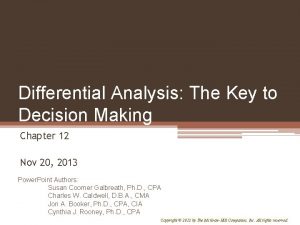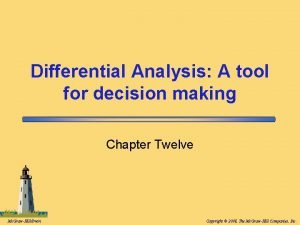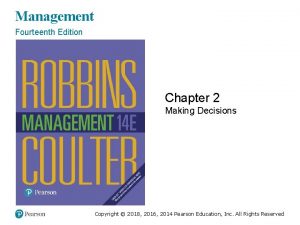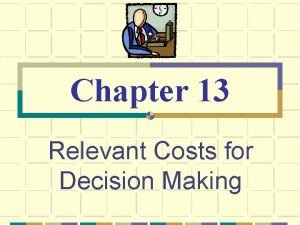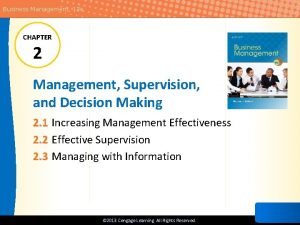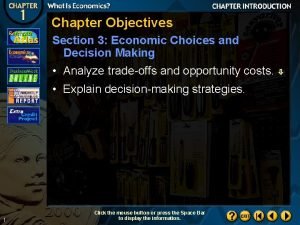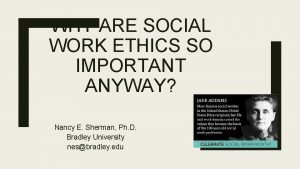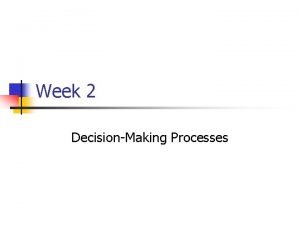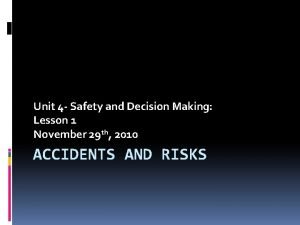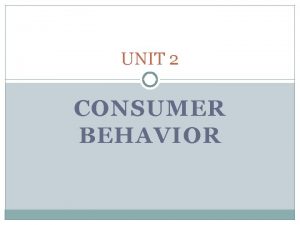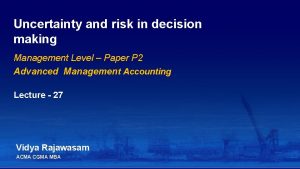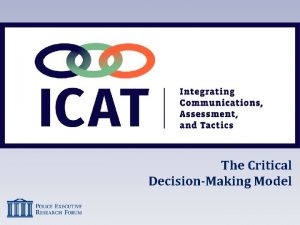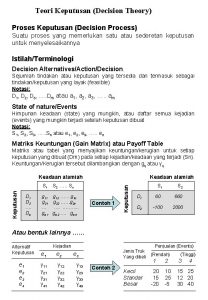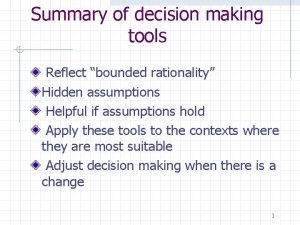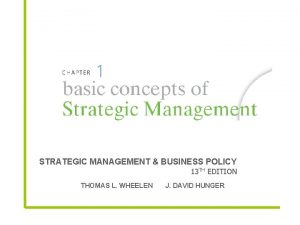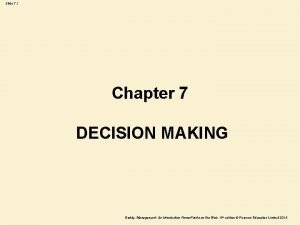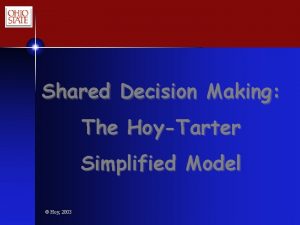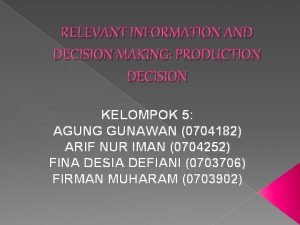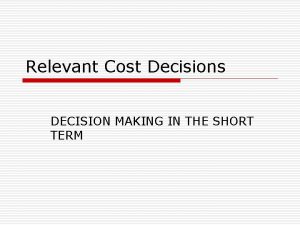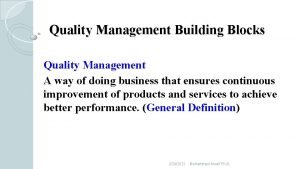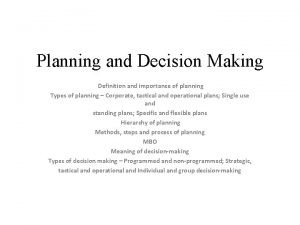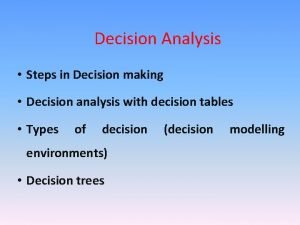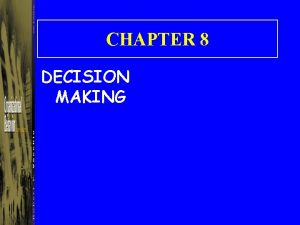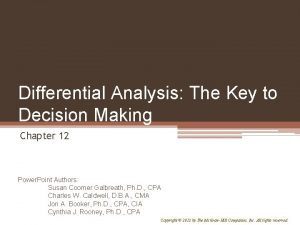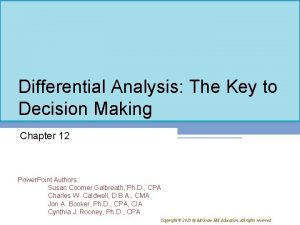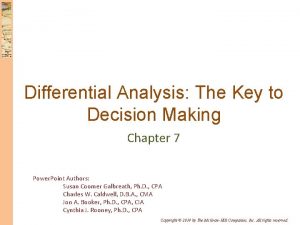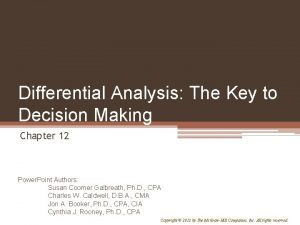Differential Analysis A tool for decision making Chapter






















































- Slides: 54

Differential Analysis: A tool for decision making Chapter Twelve Mc. Graw-Hill/Irwin Copyright © 2008, The Mc. Graw-Hill Companies, Inc.

13 -2 Learning Objective 1 Identify relevant and irrelevant costs and benefits in a decision. Mc. Graw-Hill/Irwin Copyright © 2008, The Mc. Graw-Hill Companies, Inc.

13 -3 Cost Concepts for Decision Making A relevant cost is a cost that differs between alternatives. 1 Mc. Graw-Hill/Irwin 2 Copyright © 2008, The Mc. Graw-Hill Companies, Inc.

13 -4 Identifying Relevant Costs An avoidable cost can be eliminated, in whole or in part, by choosing one alternative over another. Avoidable costs are relevant costs. Unavoidable costs are irrelevant costs. Two broad categories of costs are never relevant in any decision. They include: Sunk costs. Future costs that do not differ between the alternatives. Mc. Graw-Hill/Irwin Copyright © 2008, The Mc. Graw-Hill Companies, Inc.

13 -5 Relevant Cost Analysis: A Two-Step Process Step 1 Eliminate costs and benefits that do not differ between alternatives. Step 2 Use the remaining costs and benefits that differ between alternatives in making the decision. The costs that remain are the differential, or avoidable, costs. Mc. Graw-Hill/Irwin Copyright © 2008, The Mc. Graw-Hill Companies, Inc.

13 -6 Different Costs for Different Purposes Costs that are relevant in one decision situation may not be relevant in another context. Mc. Graw-Hill/Irwin Copyright © 2008, The Mc. Graw-Hill Companies, Inc.

13 -7 Identifying Relevant Costs Cynthia, a Boston student, is considering visiting her friend in New York. She can drive or take the train. By car, it is 230 miles to her friend’s apartment. She is trying to decide which alternative is less expensive and has gathered the following information: $45 per month × 8 months $1. 60 per gallon ÷ 32 MPG $18, 000 cost – $4, 000 salvage value ÷ 5 years Mc. Graw-Hill/Irwin Copyright © 2008, The Mc. Graw-Hill Companies, Inc.

13 -8 Mc. Graw-Hill/Irwin Identifying Relevant Costs Copyright © 2008, The Mc. Graw-Hill Companies, Inc.

13 -9 Identifying Relevant Costs Which costs and benefits are relevant in Cynthia’s decision? The cost of the car is a sunk cost and is not relevant to the current decision. The annual cost of insurance is not relevant. It will remain the same if she drives or takes the train. However, the cost of gasoline is clearly relevant if she decides to drive. If she takes the train, the cost would now be incurred, so it varies depending on the decision. Mc. Graw-Hill/Irwin Copyright © 2008, The Mc. Graw-Hill Companies, Inc.

13 -10 Identifying Relevant Costs Which costs and benefits are relevant in Cynthia’s decision? The cost of maintenance and repairs is relevant. In the long-run these costs depend upon miles driven. The monthly school parking fee is not relevant because it must be paid if Cynthia drives or takes the train. At this point, we can see that some of the average cost of $0. 569 per mile are relevant and others are not. Mc. Graw-Hill/Irwin Copyright © 2008, The Mc. Graw-Hill Companies, Inc.

13 -11 Identifying Relevant Costs Which costs and benefits are relevant in Cynthia’s decision? The decline in resale value due to additional miles is a relevant cost. The round-trip train fare is clearly relevant. If she drives the cost can be avoided. Relaxing on the train is relevant even though it is difficult to assign a dollar value to the benefit. The kennel cost is not relevant because Cynthia will incur the cost if she drives or takes the train. Mc. Graw-Hill/Irwin Copyright © 2008, The Mc. Graw-Hill Companies, Inc.

13 -12 Identifying Relevant Costs Which costs and benefits are relevant in Cynthia’s decision? The cost of parking is relevant because it can be avoided if she takes the train. The benefits of having a car in New York and the problems of finding a parking space are both relevant but are difficult to assign a dollar amount. Mc. Graw-Hill/Irwin Copyright © 2008, The Mc. Graw-Hill Companies, Inc.

13 -13 Identifying Relevant Costs From a financial standpoint, Cynthia would be better off taking the train to visit her friend. Some of the non-financial factor may influence her final decision. Mc. Graw-Hill/Irwin Copyright © 2008, The Mc. Graw-Hill Companies, Inc.

13 -14 Total and Differential Cost Approaches The management of a company is considering a new labor saving machine that rents for $3, 000 per year. Data about the company’s annual sales and costs with and without the new machine are: Mc. Graw-Hill/Irwin Copyright © 2008, The Mc. Graw-Hill Companies, Inc.

13 -15 Total and Differential Cost Approaches As you can see, the only costs that differ between the alternatives are the direct labor costs savings and the increase in fixed rental costs. We can efficiently analyze the decision by looking at the different costs and revenues and arrive at the same solution. Mc. Graw-Hill/Irwin Copyright © 2008, The Mc. Graw-Hill Companies, Inc.

13 -16 Total and Differential Cost Approaches Using the differential approach is desirable for two reasons: 1. Only rarely will enough information be available to prepare detailed income statements for both alternatives. 2. Mingling irrelevant costs with relevant costs may cause confusion and distract attention away from the information that is really critical. Mc. Graw-Hill/Irwin Copyright © 2008, The Mc. Graw-Hill Companies, Inc.

13 -17 Learning Objective 2 Prepare an analysis showing whether a product line or other business segment should be dropped or retained. Mc. Graw-Hill/Irwin Copyright © 2008, The Mc. Graw-Hill Companies, Inc.

13 -18 Adding/Dropping Segments One of the most important decisions managers make is whether to add or drop a business segment, such as a product or a store. Let’s see how relevant costs should be used in this type of decision. Mc. Graw-Hill/Irwin Copyright © 2008, The Mc. Graw-Hill Companies, Inc.

13 -19 Adding/Dropping Segments Due to the declining popularity of digital watches, Lovell Company’s digital watch line has not reported a profit for several years. Lovell is considering dropping this product line. Mc. Graw-Hill/Irwin Copyright © 2008, The Mc. Graw-Hill Companies, Inc.

13 -20 A Contribution Margin Approach DECISION RULE Lovell should drop the digital watch segment only if its profit would increase. This would only happen if the fixed cost savings exceed the lost contribution margin. Let’s look at this solution. Mc. Graw-Hill/Irwin Copyright © 2008, The Mc. Graw-Hill Companies, Inc.

13 -21 Mc. Graw-Hill/Irwin Adding/Dropping Segments Copyright © 2008, The Mc. Graw-Hill Companies, Inc.

13 -22 Adding/Dropping Segments Investigation has revealed that total fixed general factory overhead and general administrative expenses would not be affected if the digital watch line is dropped. The fixed general factory overhead and general administrative expenses assigned to this product would be reallocated to other product lines. Mc. Graw-Hill/Irwin Copyright © 2008, The Mc. Graw-Hill Companies, Inc.

13 -23 Adding/Dropping Segments The equipment used to manufacture digital watches has no resale value or alternative use. Should Lovell retain or drop the digital watch segment? Mc. Graw-Hill/Irwin Copyright © 2008, The Mc. Graw-Hill Companies, Inc.

13 -24 A Contribution Margin Approach Re tai Mc. Graw-Hill/Irwin n Copyright © 2008, The Mc. Graw-Hill Companies, Inc.

13 -25 Comparative Income Approach The Lovell solution can also be obtained by preparing comparative income statements showing results with and without the digital watch segment. Let’s look at this second approach. Mc. Graw-Hill/Irwin Copyright © 2008, The Mc. Graw-Hill Companies, Inc.

13 -26 If the digital watch line is dropped, the company gives up its contribution margin. Mc. Graw-Hill/Irwin Copyright © 2008, The Mc. Graw-Hill Companies, Inc.

13 -27 On the other hand, the general factory overhead would be the same. So this cost really isn’t relevant. Mc. Graw-Hill/Irwin Copyright © 2008, The Mc. Graw-Hill Companies, Inc.

13 -28 But we wouldn’t need a manager for the product line anymore. Mc. Graw-Hill/Irwin Copyright © 2008, The Mc. Graw-Hill Companies, Inc.

13 -29 If the digital watch line is dropped, the net book value of the equipment would be written off. The depreciation that would have been taken will flow through the income statement as a loss instead. Mc. Graw-Hill/Irwin Copyright © 2008, The Mc. Graw-Hill Companies, Inc.

13 -30 Mc. Graw-Hill/Irwin Copyright © 2008, The Mc. Graw-Hill Companies, Inc.

13 -31 Beware of Allocated Fixed Costs Why should we keep the digital watch segment when it’s showing a $100, 000 loss? Mc. Graw-Hill/Irwin Copyright © 2008, The Mc. Graw-Hill Companies, Inc.

13 -32 Beware of Allocated Fixed Costs The answer lies in the way we allocate common fixed costs to our products. Mc. Graw-Hill/Irwin Copyright © 2008, The Mc. Graw-Hill Companies, Inc.

13 -33 Beware of Allocated Fixed Costs Our allocations can make a segment look less profitable than it really is. Mc. Graw-Hill/Irwin Copyright © 2008, The Mc. Graw-Hill Companies, Inc.

13 -34 Learning Objective 3 Prepare a make or buy analysis. Mc. Graw-Hill/Irwin Copyright © 2008, The Mc. Graw-Hill Companies, Inc.

13 -35 The Make or Buy Decision When a company is involved in more than one activity in the entire value chain, it is vertically integrated. A decision to carry out one of the activities in the value chain internally, rather than to buy externally from a supplier is called a “make or buy” decision. Mc. Graw-Hill/Irwin Copyright © 2008, The Mc. Graw-Hill Companies, Inc.

13 -36 Vertical Integration- Advantages Smoother flow of parts and materials Better quality control Realize profits Mc. Graw-Hill/Irwin Copyright © 2008, The Mc. Graw-Hill Companies, Inc.

13 -37 Vertical Integration- Disadvantage Companies may fail to take advantage of suppliers who can create economies of scale advantage by pooling demand from numerous companies. Mc. Graw-Hill/Irwin Copyright © 2008, The Mc. Graw-Hill Companies, Inc.

13 -38 The Make or Buy Decision: An Example • Essex Company manufactures part 4 A that is used in one of its products. • The unit product cost of this part is: Mc. Graw-Hill/Irwin Copyright © 2008, The Mc. Graw-Hill Companies, Inc.

13 -39 The Make or Buy Decision • The special equipment used to manufacture part 4 A has no resale value. • The total amount of general factory overhead, which is allocated on the basis of direct labor hours, would be unaffected by this decision. • The $30 unit product cost is based on 20, 000 parts produced each year. • An outside supplier has offered to provide the 20, 000 parts at a cost of $25 per part. Should we accept the supplier’s offer? Mc. Graw-Hill/Irwin Copyright © 2008, The Mc. Graw-Hill Companies, Inc.

13 -40 The Make or Buy Decision 20, 000 × $9 per unit = $180, 000 Mc. Graw-Hill/Irwin Copyright © 2008, The Mc. Graw-Hill Companies, Inc.

13 -41 The Make or Buy Decision The special equipment has no resale value and is a sunk cost. Mc. Graw-Hill/Irwin Copyright © 2008, The Mc. Graw-Hill Companies, Inc.

13 -42 The Make or Buy Decision Not avoidable; irrelevant. If the product is dropped, it will be reallocated to other products. Mc. Graw-Hill/Irwin Copyright © 2008, The Mc. Graw-Hill Companies, Inc.

13 -43 The Make or Buy Decision Should we make or buy part 4 A? Mc. Graw-Hill/Irwin Copyright © 2008, The Mc. Graw-Hill Companies, Inc.

13 -44 Opportunity Cost An opportunity cost is the benefit that is foregone as a result of pursuing some course of action. Opportunity costs are not actual dollar outlays and are not recorded in the formal accounts of an organization. How would this concept potentially relate to the Essex Company? Mc. Graw-Hill/Irwin Copyright © 2008, The Mc. Graw-Hill Companies, Inc.

13 -45 Learning Objective 4 Prepare an analysis showing whether a special order should be accepted. Mc. Graw-Hill/Irwin Copyright © 2008, The Mc. Graw-Hill Companies, Inc.

13 -46 Key Terms and Concepts A special order is a one-time order that is not considered part of the company’s normal ongoing business. When analyzing a special order, only the incremental costs and benefits are relevant. Mc. Graw-Hill/Irwin Copyright © 2008, The Mc. Graw-Hill Companies, Inc.

13 -47 Special Orders Ø Jet, Inc. makes a single product whose normal selling price is $20 per unit. Ø A foreign distributor offers to purchase 3, 000 units for $10 per unit. Ø This is a one-time order that would not affect the company’s regular business. Ø Annual capacity is 10, 000 units, but Jet, Inc. is currently producing and selling only 5, 000 units. Should Jet accept the offer? Mc. Graw-Hill/Irwin Copyright © 2008, The Mc. Graw-Hill Companies, Inc.

13 -48 Special Orders $8 variable cost Mc. Graw-Hill/Irwin Copyright © 2008, The Mc. Graw-Hill Companies, Inc.

13 -49 Special Orders If Jet accepts the offer, net operating income will increase by $6, 000. Note: This answer assumes that fixed costs are unaffected by the order and that variable marketing costs must be incurred on the special order. Mc. Graw-Hill/Irwin Copyright © 2008, The Mc. Graw-Hill Companies, Inc.

13 -50 Quick Check Northern Optical ordinarily sells the X-lens for $50. The variable production cost is $10, the fixed production cost is $18 per unit, and the variable selling cost is $1. A customer has requested a special order for 10, 000 units of the X-lens to be imprinted with the customer’s logo. This special order would not involve any selling costs, but Northern Optical would have to purchase an imprinting machine for $50, 000. (see the next page) Mc. Graw-Hill/Irwin Copyright © 2008, The Mc. Graw-Hill Companies, Inc.

13 -51 Quick Check What is the rock bottom minimum price below which Northern Optical should not go in its negotiations with the customer? In other words, below what price would Northern Optical actually be losing money on the sale? There is ample idle capacity to fulfill the order and the imprinting machine has no further use after this order. a. $50 b. $10 c. $15 d. $29 Mc. Graw-Hill/Irwin Copyright © 2008, The Mc. Graw-Hill Companies, Inc.

13 -52 Quick Check What is the rock bottom minimum price below which Northern Optical should not go in its negotiations with the customer? In other words, below what price would Northern Optical actually be losing money on the sale? There is ample idle capacity to fulfill the order and the imprinting machine has no further use after this order. Variable production cost $100, 000 a. $50 Additional fixed cost + 50, 000 b. $10 Total relevant cost $150, 000 c. $15 Number of units 10, 000 d. $29 Average cost per unit = $15 Mc. Graw-Hill/Irwin Copyright © 2008, The Mc. Graw-Hill Companies, Inc.

13 -53 Activity-Based Costing and Relevant Costs ABC can be used to help identify potentially relevant costs for decision-making purposes. However, before making a decision, managers must decide which of the potentially relevant costs are actually avoidable. Mc. Graw-Hill/Irwin Copyright © 2008, The Mc. Graw-Hill Companies, Inc.

13 -54 Mc. Graw-Hill/Irwin End of Chapter 13 Copyright © 2008, The Mc. Graw-Hill Companies, Inc.
 Differential analysis the key to decision making
Differential analysis the key to decision making Differential analysis the key to decision making
Differential analysis the key to decision making Objectives of decision making
Objectives of decision making Slidetodoc.com
Slidetodoc.com Lung cancer screening shared decision making tool
Lung cancer screening shared decision making tool Swot analysis decision making
Swot analysis decision making Sebastian lemire
Sebastian lemire Chapter 6 prices and decision making assessment answers
Chapter 6 prices and decision making assessment answers Chapter 11 decision making and relevant information
Chapter 11 decision making and relevant information Chapter 2 economic systems and decision making answer key
Chapter 2 economic systems and decision making answer key Management chapter 5 planning and decision making
Management chapter 5 planning and decision making Chapter 3 financial decision making
Chapter 3 financial decision making Chapter 2 economic systems and decision making
Chapter 2 economic systems and decision making Copyright
Copyright Relevant cost for decision making solution chapter 13
Relevant cost for decision making solution chapter 13 Chapter 2 economic systems and decision making
Chapter 2 economic systems and decision making Chapter 11 decision making and relevant information
Chapter 11 decision making and relevant information Chapter 2 management supervision and decision making
Chapter 2 management supervision and decision making Decision making and relevant information
Decision making and relevant information Management chapter 5 planning and decision making
Management chapter 5 planning and decision making Chapter 1 section 3 economic choices and decision making
Chapter 1 section 3 economic choices and decision making Decision tree and decision table examples
Decision tree and decision table examples Youth involvement
Youth involvement Nasw code of ethics
Nasw code of ethics Systematic decision making process
Systematic decision making process Paced decision making
Paced decision making Using recursion in models and decision making
Using recursion in models and decision making Using functions in models and decision making
Using functions in models and decision making Paced decision making
Paced decision making Unit 4 lesson 1 decision making
Unit 4 lesson 1 decision making Decision making to improve marketing performance
Decision making to improve marketing performance Types of decision making
Types of decision making Internal business management
Internal business management Contribution payoff table
Contribution payoff table Decision categories
Decision categories Marketing research roles
Marketing research roles Critical decision making
Critical decision making Decision theory adalah
Decision theory adalah Tactical decision making adalah
Tactical decision making adalah What is the dare decision making model
What is the dare decision making model Rational decision making model
Rational decision making model Mintzberg's modes of strategic decision making
Mintzberg's modes of strategic decision making Paced decision making
Paced decision making Decision making conditions
Decision making conditions Sbdm roles and responsibilities
Sbdm roles and responsibilities Hoy and tarter decision making model
Hoy and tarter decision making model Decision making and relevant information
Decision making and relevant information Steps in decision making
Steps in decision making Building blocks of quality
Building blocks of quality Abcde decision making model
Abcde decision making model Reasoning judgement and decision making
Reasoning judgement and decision making Best books on problem solving and decision making
Best books on problem solving and decision making Individual and group decision making
Individual and group decision making What graphical model is appropriate for decision-making?
What graphical model is appropriate for decision-making? Individual and group decision making
Individual and group decision making
